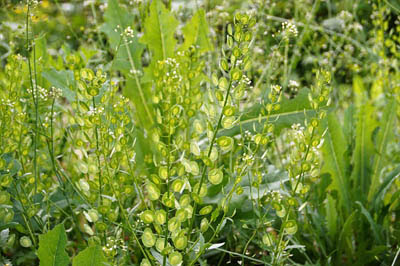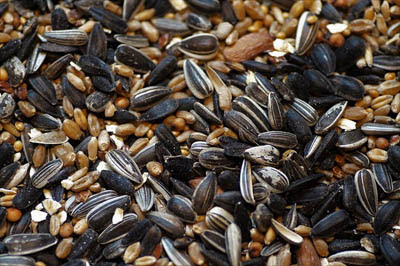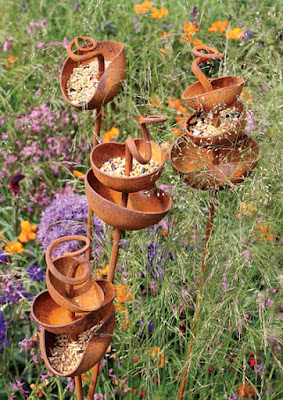Last Updated on January 3, 2024 by Greg Gillson
It is inevitable that uneaten seeds will spill out of your bird feeders. The birds themselves may knock some of it out in all of their activity. This uneaten seed will germinate and sprout in your lawn under your feeders. How do you keep sprouting bird seed under control?
You can keep bird seed from sprouting by changing your seeds, changing your feeder, and changing your landscaping using the 14 tips that follow.
First, let’s find out a bit about the seeds in the birdseed! What is it?
Almost all bird seed will sprout. If an unwanted plant is defined as a weed, then bird seed that sprouts is a weed. Some sprouting bird seed may look like grass at first. But bird seeds grow into whatever seed you are feeding: sunflowers, millet, wheat, milo, flax, rapeseed, canary seed. How do you keep bird seed from growing under your feeder?
Change your seeds
Sterilized seeds
Sterilized seeds are heated so that they die. If they fall on the ground they will not germinate and sprout.
Tip 1. Feed Niger seed (thistle)
Niger is not really thistle. This plant seed is also sold under the trademark name Nyjer. It does not germinate and sprout in your lawn–for one very good reason.
In 2001 the USDA required imported Niger seed for birds to be sterilized for 15 minutes at 120˚ C (248˚ F). This sterilizes the seeds.
Since it is sterilized it will not sprout under your bird feeder. This is a favorite food of small finches such as goldfinches, siskins, and house finches.
Tip 2. Sterilize your own seeds
The Niger seed is the only bird seed you are likely to find that has been sterilized. But you can sterilize your own bird seed the very same way. Baking bird seed will stop it from sprouting.
Spread bird seed on a flat baking sheet that has a lip all the way around. Preheat your conventional oven to 250˚ F. Place the baking sheet with bird seed in the oven and bake for 15 minutes.
Alternatively, I have seed directions to place 5 pounds of bird seed into a paper sack and cook in the microwave on High for 5 minutes. I have also heard some people have accidentally burned their bird seed this way. So try it for lesser amounts of time. Then put it in wet conditions (e.g., damp paper towel in bottom of a glass) for 7 days and see if it sprouts or not.
This sounds like way too much work, though. How about some other ideas?

Feed only seeds that birds like
Just like you, birds have a preference of foods they like. They get up on the feeder and scratch through the mixed seeds, searching for their favorite food.
Many types of mixed bird seed contains filler: cheap seeds that most birds don’t like. Birds toss aside the undesirable seed, often on the ground. This discarded bird seed is likely to sprout.
Tip 3. Feed one type of bird seed in separate feeders
Feeding one type of seed in each feeder will result in birds only visiting the feeder with their favorite foods. They’ll eat this seed, not throw it away. Thus, less bird seed will fall on the ground to sprout.
This tip doesn’t stop accidental spillage. It stops birds from throwing away seeds they don’t like.
Tip 4. Buy fresh bird seed

Cheap bird seed may be cheap for a reason. It may be stale and old. Birds may toss it aside looking for something fresh. Or they may abandon the feeder altogether. Birds will eat more of the fresh seed and not toss away the old. It is best not to store bird seed from one season to the next. Buy new.
Tip 5. Don’t buy bird seed with milo
Most birds don’t like milo. They throw it out of the feeder. It sprouts.
Wheat, rapeseed and canary seed are similar.
Why is milo in bird seed? Chickens like it in chicken scratch. It is very cheap and the bird seed manufacturers already use it. Some bird seed is more than 50% milo. It ends up growing in your lawn.
No mess bird seed
Tip 6. Feed No-mess bird seed
Many mixed seed varieties feature a no-mess or no-waste bird seed. These contain such bird foods as hulled sunflower seeds (seeds without hulls), hulled white proso millet, sunflower chips (hulled and broken), peanut pieces, cracked corn, dried fruits, and nuts (without the shell).
You can purchase a mixed blend containing those seeds and others. You can buy hulled sunflower and other seeds.
Not only will these seeds stop bird seed from sprouting, there will also be no mess from the inedible seed hulls. This is great for patios, lawns, and other areas where you don’t want any mess under the feeder.
Change your feeder
Feeders themselves don’t stop bird seed from sprouting. However, the bird feeder and how it is hung up can change the amount of seed falling to the ground uneaten.
Stabilize bird feeders
Tip 7. Stop your bird feeders from swinging
Some bird seed may spill from your feeder as it sways in the wind. Even birds jumping on and off the feeder may cause it to swing wildly. You may need to shorten the hanger. You may try tying the bottom of the feeder. You may add weight to the bottom of the feeder. It may be that you need to buy a different, perhaps shorter and wider, bird feeder.
Or, perhaps, the bird feeder pole is swaying. In that case, you need a stouter pole or a lighter feeder. A light feeder may swing in the wind easier, though.
Catch those seeds!
Seed catcher
Tip 8. Install a seed catcher on the bird feeder pole or hang below your feeder
You can buy seed catcher trays that hang under most styles of bird feeders. Then you can catch both the discarded hulls and any whole seeds that might have fallen from the feeder. It keeps the ground under your bird feeder much cleaner!
Proper feeder for proper seeds
Tip 9. Feed birds black oil sunflower seeds in tube feeders with small feeder ports
Birds such as chickadees, titmice, and nuthatches eat only one sunflower seed at a time. They fly away to a tree branch to hammer it open to eat the kernel inside. Then they return to the feeder. This feeding behavior causes fewer seeds to be spilled.
House finches sit on the feeder and “chew” the seeds, cracking them open and dropping the hulls out of the feeder. Sometimes the birds accidentally pull out extra seeds that drop to the ground. But there is certainly less fallen seed than in hopper and platform feeders, where birds stand in the tray with the seeds.

Tip 10. Feed mixed bird seed in a low platform feeder
Platform feeders are messy. Birds stand in the feeder with the seeds.
Birds that like to eat from platform feeders, like sparrows and towhees, naturally kick the ground with both feet at once in a kind of hop-kick. They do this on the ground to dig up the soil and turn over leaves. They do this in the feeder, too. They can’t help themselves.
A low platform feeder doesn’t stop the amount of bird seeds kicked out. But it does help keep it confined to a smaller area. Then those ground-feeding birds can locate the spilled seeds easier and eat more of it up from the ground.
Change your landscaping
Make the ground under your feeder easier to clean
The inedible hulls of the sunflower seeds that the birds “spit out” have a natural chemical that keeps most other plant seeds from germinating. Thus, the ground under your feeder is often bare of grass.
Tip 11. Add pavers or flagstones under your feeders
Since the ground under your feeders may be a mess anyway, add pavers. A square of 9 or 16 pavers set close together will be easy to sweep up. Seeds that fall in the cracks and sprout are easy to pull up.
Tip 12. Clean up spilled seed before it sprouts
Regularly rake or sweep up the hulls and spilled seeds before they germinate. You may wish to invest in an outdoor backpack vacuum/blower. You need one anyway, for those fall leaves, right?
Accept the mess!
Tip 13. Move your feeders to the edge of your lawn where it doesn’t matter
Perhaps there’s an area at the edge of your lawn that you can let go to dirt. This can be under some evergreen bushes. It could be at the edge of a “wild” area.
Tip 14. Create a flower garden under your feeder
Remember I said that sunflower hulls prevent some other plants from growing? Some. Not all.
Plant flowers under your bird feeder and let them grow wild! Wild geraniums, day lilies, clematis, lupines, dahlias, mint, cotoneaster, lemon balm, purple coneflowers. Get the idea? A few stray bird seed sprouts won’t even be noticed!

Wrapping Up
Feeding bird seed to wild birds can be a good idea. Here are some of the benefits of giving bird seed to wild birds.
- Supplemental food: Bird seed can provide a valuable source of energy, especially during challenging times like harsh winters, periods of drought, or during migration when natural food sources may be scarce.
- Boosting local bird populations: By offering consistent food, your feeder can attract a variety of birds to your backyard, enriching your own environment and potentially aiding nesting success.
- Educational opportunity: Birdwatching at a feeder can be a fun and educational activity for children and adults alike, fostering a connection with nature and appreciation for local wildlife.

Frequently Asked Questions
Can I feed peanuts to wild birds?
Yes, you can feed peanuts to wild birds but try to put them as a mix with other ingredients.
- Nutritious: Peanuts are a good source of protein, fat, and other essential nutrients, especially during harsh weather or migration.
- Popular: Many bird species, particularly larger ones like jays, crows, and woodpeckers, love peanuts.
- Easy to find: Peanuts are readily available and relatively inexpensive.
What is the difference between wild bird seed and pet bird seed?
While both wild bird seed and pet bird seed contain seeds, there are some key differences between them:
Wild bird seed
Generally high in fat and carbohydrates, especially from sunflower seeds and safflower, providing quick energy for birds outdoors with varying food sources. Can lack essential nutrients like protein and minerals.
Pet bird seed
Formulated to provide a more balanced diet, often containing a wider variety of seeds, pellets, and grains to ensure birds get the protein, vitamins, and minerals they need. May sometimes include dried fruits and vegetables.
When should you not put out bird seed?
- Spring and summer months often see a surge in natural food sources like insects, fruits, and berries. During this time, birds rely less on supplemental feeding and may not visit your feeders frequently. Taking a break helps conserve seed and protects birds from potential dependence on feeders.
- Some areas have regulations restricting bird feeding due to concerns about attracting unwanted species like pigeons or potential disease transmission. Always check local ordinances before putting out feeders and be mindful of your community’s rules.
- Bird feeders can attract raccoons, squirrels, and other animals that may cause damage or pose a threat to birds. If you encounter these issues regularly, consider taking down feeders or taking steps to make them inaccessible to non-bird species.
Related article: How to feed birds without the mess














Thanks for all the tips!
Great info.
You are most welcome.
Is sprouting bird seeds bad for pets to chew on
I don't think so. As long as it is a seed they normally eat. Many birds eat buds and sprouts.
Thank you!
You are welcome Samantha!
Thank you for the suggestions! I have a question about something else. I started with a window feeder that cardinals frequented. Then I changed to a hanging feeder intended for cardinals. However, now all of my feeders have been inundated with finches, so the cardinals seem to be relegated to ground feeding, and I only see one or two. I've seen a cardinal or two at the new feeders, but most of them have disappeared. I have nyjer in the feeders for finches and safflower for the cardinals, but the finches are little piggies and eating it all!
It sounds like you are doing everything you can.
Finches like feeding high, cardinals often prefer to feed on the ground. Thus, it may be slightly easier to get finches to visit feeders than cardinals.
I believe that that part of what you are seeing is also that the house finches are more social.
The cardinals are highly territorial. During the breeding season (which we have entered now) one pair will drive away all others. So it makes sense that during this late spring/early summer time period, that you will see only one or two pairs of cardinals at your feeders.
The good news is that in later summer all the young birds will start coming to your feeders from nearby areas.
This information is meaningful and magnificent which you have shared here about the wild bird seed. I am impressed by the details that you have shared in this post and It reveals how nicely you understand this subject
You could have just said "come see my site."
I use shelled bird seed from a popular bird store and it still grew weeds, but I don’t understand how if already shelled. It didn’t used to. Just wanted to let you know it can happen. Jen
Thanks Jen!
I purchased a bag of what was labeled Sunflower Chips. However, they’re whole meats without the shell. I thought they wouldn’t sprout but lo and behold, I had tons of sprouts in my lawn under the feeder. So, I bought actual broken pieces of sunflower from a bird feed store 79 miles away from home which I love. The finches are actually eating the small pieces and not throwing anything out. Obviously I don’t want to drive 158 miles round trip to get finch food so do you know of a source online that carries the actual chopped up seeds? And why do they call them chips if they’re still whole meats?
Wow. Those must have been fresh to sprout even without the shell.
Don't buy "coarse" sunflower chips. But "medium" or "fine." The coarse chips are more likely to be whole, without the shell.
https://amzn.to/3CC44Rb
I have smaller feeders for my finches. A proper finch feeder and then a little hanging dish with mixed no waste seeds. Then, a ways away, I have a large flat feeder for the doves, blue jays and cardinals. They seem to eat in shifts.
Wow! A plant grew in my garden and went to seed. I planted those seeds and got a plant that grew like grass and filled out. The tips went to seed. Early ones small, but later ones have a reddish brown seed that shows out of the hull, but birds not eating it yet. Wonder is it millet, sorghum or what and can we eat it?
What bird is white with Pinkish-red on head and wings, flys in a up down undulating pattern very fast, about the size of a robin or cardinals, love grapes and make a sound like a broken computer. Saw them in Midwest Illinois.
Possibly Pine Grosbeak. House Finches is more likely, but smaller and red-orange.
Great readiing